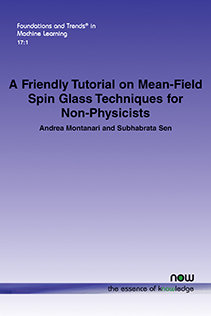A Friendly Tutorial on Mean-Field Spin Glass Techniques for Non-Physicists
By Andrea Montanari, Department of Electrical Engineering and Department of Statistics, Stanford University, USA, montanari@stanford.edu | Subhabrata Sen, Department of Statistics, Harvard University, USA
Abstract
Mean-field spin glasses are a class of high-dimensional random cost (energy) function with special exchangeability properties. Random probability measures are defined from these energy functions by the usual Boltzmann formula. Over the last 40 years, an arsenal of sophisticated mathematical techniques (both rigorous and non-rigorous) has been developed to characterize these models. More recently, these techniques have been successfully applied to a number of canonical models in high-dimensional statistics and machine learning, which fit the same framework. This tutorial provides an introduction to such techniques, aimed at non-specialists.
A Friendly Tutorial on Mean-Field Spin Glass Techniques for Non-Physicists
Spin glass models were introduced by physicists in the 1970s to model the statistical properties of certain magnetic materials. Over the last half century, these models have motivated a blossoming line of mathematical work with applications to multiple fields, at first sight distant from physics.
This tutorial is deliberately written in a somewhat non-standard style, from several viewpoints. Rather than developing the theory in the most general setting, the authors focus on two concrete problems that are motivated by questions in statistical estimation. Their treatment is far from exhaustive, but they do not hesitate to pursue detours that are interesting, but indirectly related to the original questions posed by the examples. The authors also present a mixture of non-rigorous and rigorous techniques. The authors clearly indicate when something is proven and explain non-rigorous techniques on examples for which rigorous alternatives are available.
Written by two recognized experts and based on a course given at Stanford University, this tutorial is a unique introduction to a topic that has many avenues for furthering research in statistics, mathematics, and computer science. It provides an accessible tutorial to understand and use the theories being deployed in physics for over 50 years.
